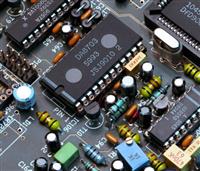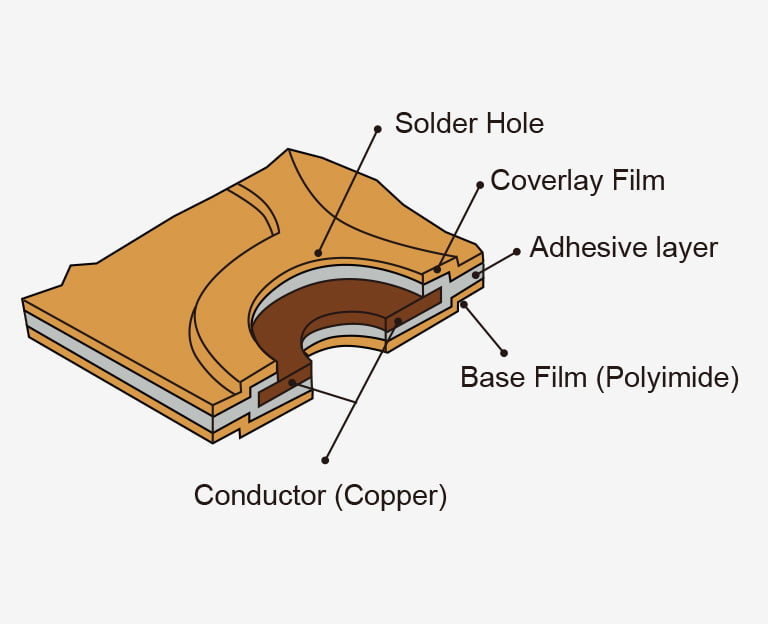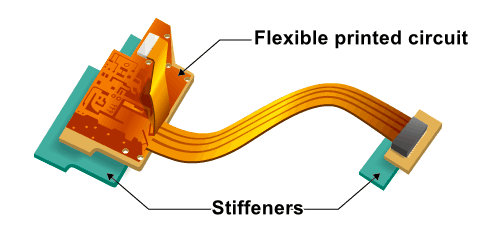
Flex PCB, also known as FPC, is a patterned arrangement of printed circuits and components that make use of flexible base material with or without a flexible cover layer. It has a structure in which a base film (polyimide, etc.) is used as a film insulator and an adhesive layer and a conductor foil are laminated on it. The biggest feature of this board is its thinness and softness. Its electrical characteristics do not change even if it is bent or twisted.
.png)
Figure 1: Flex PCB manufactured by PCBGOGO
Main materials in Flex PCBs
1. Substrate
Adhesive and adhesive-free substrates are two common base materials for flexible PCBs.The adhesive substrate is mainly composed of copper foil, adhesive, and polyimide( PI). The material with only one copper foil is a single-sided substrate, and for a Double-sided substrate, there are two copper foils. The adhesive-free substrate, as the name suggested, is a material without an adhesive layer. Compared with the ordinary adhesive substrate, the adhesive-free substrate is more popular as it is thinner and has better dimensional stability, higher heat resistance, higher bending resistance, better chemical resistance, and other advantages.

Figure 2: Basic structure of Flex PCB
2. Coverlay
Since the copper oxidizes easily, the exposed surfaces of the flex PCBs are often covered with a protective layer that serves the same function as the solder mask used on a rigid PCB. The preferred material used for coverlay is polyimide (PI), whose natural brown color is what we commonly see on a flex PCB. It is a high-temperature polymer containing an imide ring structure on the main chain of the molecule with outstanding dielectric properties, mechanical properties, radiation resistance, and wear resistance at high temperatures.
3. Stiffeners
Stiffeners are particularly used to reinforce particular parts of flexible circuitry for component support, durability, and mounting. The common material used as stiffeners includes FR-4, PI, Steel sheet.
1) FR-4 stiffener: It consists of glass fiber cloth and epoxy resin glue, which is the same as the FR4 material used in rigid PCBs;
2) Steel sheet stiffeners: It has strong hardness and support strength but requires manual assembly and a more complicated assembly process. The cost for this kind of stiffeners will be higher.
3) PI stiffeners: It is the same material as the coverlay, which contains three parts, release paper, adhesive, and PI while the PI layer is thicker from 2MIL to 9MIL.
Figure 3: Stiffeners in Flex PCB
Advantages of Flex PCBs
The future trend of electronic products is miniaturization and high density. FPC can be twisted, bent, and folded, which greatly improves space utilization, reducing the size and weight of the final products.
Flex PCBs can move and expand arbitrarily in three-dimensional space so as to achieve the integration of components assembly and wire connection. This facilitates the assembly process to a certain extent and enhances the reliability of the circuits.
Flex PCBs also provide good heat dissipation and excellent electrical performance. It can quickly transmit electrical signals and help the devices function correctly.
Drawbacks of Flex PCBs
1. High initial cost
Flexible PCBs are usually designed for special applications. The cost regarding the circuit design, wiring, and photographic negatives are higher than Rigid PCBs.In the case where cost is a determining factor, flexible PCB is not an ideal option.
2. Hard to correct and repair
It is hard to correct or modify the design on a flex PCB as any change should be conducted on the very base layer. And its surface is covered with a layer of protective film, which must be removed first if any repair is needed and restored after the repair work is finished.
3. Easy to be damaged
Improper operation during the assembly process can easily cause damage to the flexible circuit. Its soldering and rework require trained personnel to operate.
4. Size limited
The size of Flex PCBs is currently limited by the production equipment. It can not be made as long and wide as rigid PCBs.
.png)
Figure 4: Flex PCB manufactured by PCBGOGO
Applications of Flex PCBs
Flexible PCB is characterized by its shape and usage. It is a kind of board with a high degree of freedom thanks to its "thinness" and "softness". It can withstand millions of dynamic bending without changing its electrical properties, so it has the advantage of being able to maximize its properties. Taking advantage of this property, Flexible PCB is usually used as a connecting cable for connecting moving parts, curved parts, boards, and units that need to be thinner and lighter. For example, we can see it in keyboards, calculators, LCD monitors, and printer heads. Flexible PCB is also applied in mobile devices like folding screen phones and three-dimensional circuits like camera lens parts. In the case where special weight reduction is required such as in aerospace, military application, flexible PCB is widely used.
Conclusion
Flex PCBs have vast applications because of their bendable, flexible properties and excellent electrical and thermal performance. As the electronics products come in smaller and lighter sizes, the need for Flex PCBs is growing. PCBGOGO is a professional Flex & Rigid-Flex PCB manufacturer in the industry for over 10 years. Possessing a team of experts with good knowledge of the Flex PCBs, they can help you in selecting the right one based on your application requirements. From prototype through assembly, they are able to meet your needs with short lead times. Contact them today to proceed with your Flex PCBs project!
- Comments(4)
J****obu
Jul 03.2024, 22:28:09
W****son
Jun 28.2024, 13:03:23
**
Jun 14.2024, 17:45:44
**
May 06.2024, 12:11:07


